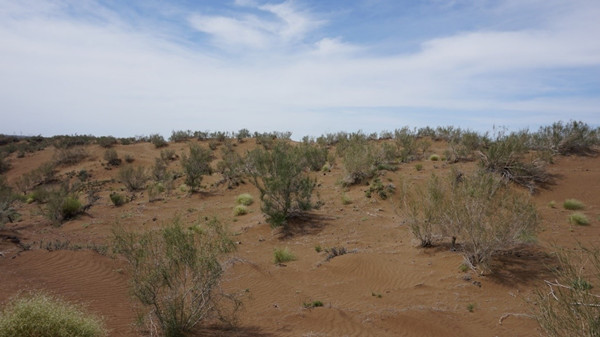Oct 16 2020
Thirty-four million years ago, unexpected climate change led to an ecological collapse in Central Asia. Deserts formed across the lowlands, and biological diversity was indefinitely affected.
 The desert-steppes in the southern Gurbantunggut Desert, where vegetation cover is less than 30%. One of the only plants that can grow in the sandy soils is saxaul (Haloxylon ammodendron), a shrub that is at risk of extinction. Image Credit: ZHANG Hongxiang, Xinjiang Institute of Ecology and Geography, Chinese Academy of Sciences.
The desert-steppes in the southern Gurbantunggut Desert, where vegetation cover is less than 30%. One of the only plants that can grow in the sandy soils is saxaul (Haloxylon ammodendron), a shrub that is at risk of extinction. Image Credit: ZHANG Hongxiang, Xinjiang Institute of Ecology and Geography, Chinese Academy of Sciences.
These results were presented by an international team, guided by researchers from the University of Amsterdam, Stockholm University, and the CNRS (France). The study findings have now been reported in Science Advances, a scientific journal.
The research incorporated fossil pollen (the reproductive element of plants) from Asia with faunal, geological, and climate datasets. This unraveled an ecological disaster roughly 34 million years ago, due to quick changes in atmospheric carbon dioxide and climate.
Huge areas of Tibet, Mongolia, and northwestern China transformed into hyperarid deserts with minimal vegetation cover. Larger animals were chiefly replaced by small mammals such as rodents. Currently, deserts are once again growing quickly across the region, perhaps indicating new ecological destruction.
Unique Biological Diversity
The results have major implications for future biodiversity, agriculture, and human wellbeing. Evidence from the past shows us that the Central Asian region will never recover its unique biological diversity if desertification continues.
Dr Natasha Barbolini, Study Lead Author and Researcher in Paleoecology, University of Amsterdam
Barbolini is currently at Stockholm University.
The research is based on the model predictions from the Intergovernmental Panel on Climate Change (IPCC) and the latest climate records indicating that interior Asia is rapidly turning into one of the driest and hottest places on Earth. Climate change, similar to what was experienced 34 million years ago, may again cause permanent ecosystem change and biodiversity loss.
Ancient Climate Change and Mountain Building
Piecing together 43 million years of evolution allowed us to understand resilience of these ecosystems in a completely new way. Even though some of the plants that once dominated still exist in the region today, they are relatively rare. This shows that populations can be permanently altered by rapid climate change, even if widespread extinctions don’t occur.
Dr Carina Hoorn, Study Co-Lead Author and Associate Professor, Institute for Biodiversity and Ecosystem Dynamics, University of Amsterdam
The research discovered that present Asian biodiversity has been dictated by these ancient climatic changes, as well as by mountain building and creation of the Tibetan Plateau.
“Central Asia, once covered by a vast shallow sea, has become one of the driest places on Earth due to the collision of India with Asia and the uplift of the Himalayan mountain range,” stated Guillaume Dupont-Nivet at CNRS (France) that supervises the project sponsored by the European Research Council.
Currently, Central Asia is where some of the oldest deserts and highest mountains outside of the Himalayas can be found. This climatic and geological diversity has created a surprising number of species that make this region their habitat.
However, at present, these species are at risk from current climate change—along with nearly half a billion people, who are finding it highly challenging to make a living. Crops are destroyed by drought, and the increasing seas of sand are taking over native steppes required for livestock to graze.
Lost to the Desert
These modern herb-dominated steppes only emerged when the climate became temporarily wetter, about 15 million years ago. Before that it was simply too dry. Our results show that once the process of desertification begins, it can spread rapidly and last for millions of years. This is because vegetation prevents erosion and concentrates water and nutrients in the topsoil. If that vegetation is lost, it cannot easily reappear.
Amber Woutersen, Study Co-Lead Author and Research Associate, Institute for Biodiversity and Ecosystem Dynamics, University of Amsterdam
In the paper, aptly published in the International Year of Plant Health, the researchers raise awareness that Asian steppes are being altered for human use and lost to desertification at record rates. This development must be reversed to safeguard what has currently become one of the world’s most endangered terrestrial biomes.
Journal Reference:
Barbolini, N., et al. (2020) Cenozoic evolution of the steppe-desert biome in Central Asia. Science Advances. doi.org/10.1126/sciadv.abb8227.